Take it offline!
This Education in Motion resource is also available as a printable PDF.
Download PDF
Intelligent Rotation in Space (IRIS) technology on the QUICKIE IRIS® was designed for the seat frame to rotate around the user's center of gravity, resulting in a smooth tilting motion and a system that remains balanced within a tilted position. Functionally, this design results in a tilt that is easy to control and allows for the shortest possible wheelbase that is easy to maneuver. Ultimately, prescription and final adjustments to this highly configurable system will impact the ease with which the chair can tilt and is essential to optimizing its performance.
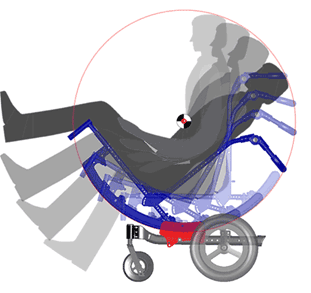
The small red, white, and black circle in the very center of the graphic above shows the alignment of the person's center of gravity with the center of rotation of the tilt mechanism. The shaded areas of the seated person illustrate that whatever degree of tilt the seat is in, the person's center of gravity and center of rotation remain aligned. Because there is no horizontal movement of the person's center of gravity and different degrees of tilt, the wheelbase is shorter than wheelchairs with other tilt mechanisms, while still providing stability in different degrees of tilt.
Improving Tilt Performance
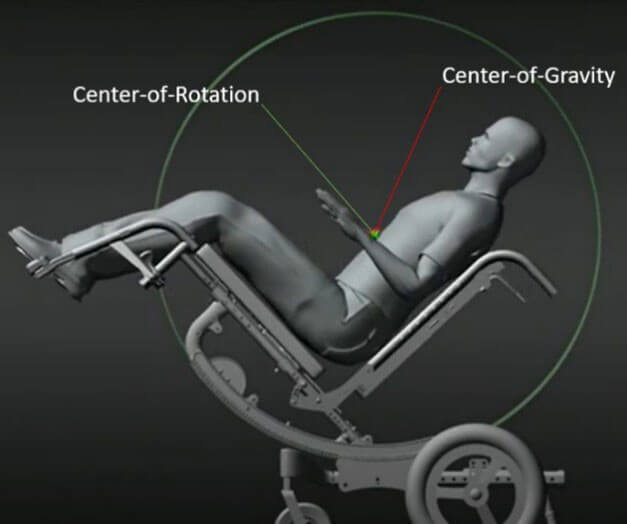
When designing a chair, the center of rotation can be determined based on two different methods:
- Set up by QUICKIE: utilizing the client's seated height, weight, and desired seat depth
- Set up by Depth: utilizing the frame depth range and pre-selected frame depth
These methods help QUICKIE to optimize the wheelchair's center of rotation (COR) with the client's center of gravity (COG).
Note: The addition of any aftermarket backrest, custom mold, ventilator, and any number of additional medical or personal items are not accounted for as part of this configuration. Therefore, it is recommended that the ease of tilt be assessed by the clinician and assistive technology professional/certified rehab technology supplier upon delivery to ensure optimal tilt performance for the client and caregiver, along with durability of the tilt mechanism over time.
In order to optimize tilt performance along with overall wheelchair performance and maneuverability, there are three different independent adjustments that need to be considered:
- Center of Gravity and Center of Rotation Adjustment
- Front Stability Adjustment
- Rear Stability Adjustment
Center of Gravity and Center of Rotation (CG-CR) Adjustment
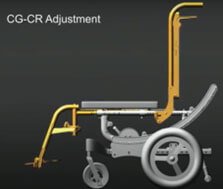
Complete a CG-CR Adjustment by moving the back canes and the leg rest hanger assembly an equal distance to bring them into alignment while maintaining seat depth. This may impact the overall wheelchair stability as the entire seating system has been moved. Therefore, the front or rear stability may need to be adjusted next.
If the client's COG is positioned in front of the wheelchair's COR: the chair will tend to rotate forward out of tilt and into an upright position. This will result in forward instability or tipping forward when going down a slope and will be more difficult for the caregiver to tilt the wheelchair back.
If the client's COG is positioned behind the wheelchair's COR: the chair will tend to rotate back and into a full tilt position. This will result in rearward instability or tipping backward when going up a slope and will be more difficult for the caregiver to tilt the wheelchair upright. Remember, this may also be exacerbated by any personal or medical items placed on the back of a client's wheelchair.
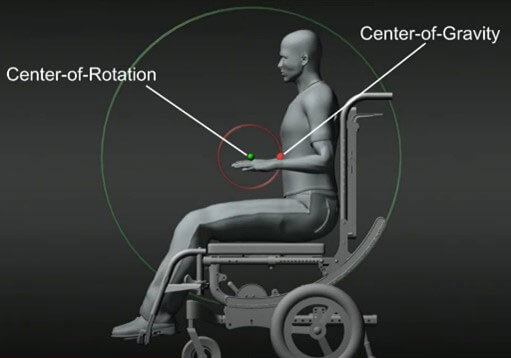 In this case, completing the CG-CR adjustment will move the seating system forward relative to the caster wheels, impacting the front stability.
In this case, completing the CG-CR adjustment will move the seating system forward relative to the caster wheels, impacting the front stability.
Front Stability Adjustment
The front stability adjustment allows you to reposition the carriage over the base frame.
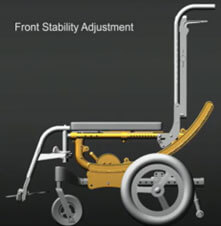 In this case, front stability was improved by moving the carriage rearward to realign the hanger and the front caster, making it less forward tippy.
In this case, front stability was improved by moving the carriage rearward to realign the hanger and the front caster, making it less forward tippy.
Rear Stability Adjustment
The rear stability adjustment can be completed by moving the rear wheel forward or backward on the base frame.
 In this case, the center of gravity passes over the axle of the rear wheel. By moving the rear wheel back on the base frame, the rear stability was improved to ensure client and caregiver safety when propelling up an incline.
In this case, the center of gravity passes over the axle of the rear wheel. By moving the rear wheel back on the base frame, the rear stability was improved to ensure client and caregiver safety when propelling up an incline.
Additional Resources
If you have questions regarding how to make these adjustments, please visit the Instructional Video Gallery, located within the Technician Support Center on our Dealer & Clinician Resources page, or visit the Sunrise Medical YouTube channel, where you can view these adjustments and other videos provided by our technical education team.
References
- Consortium for Spinal Cord Medicine, Pressure Ulcer Prevention and Treatment Following Spinal Cord Injury: A Clinical Practice Guideline for Health-Care Professionals 2nd. ed., 2014.
- Cicianno, B. E., Lieberman, J., Schmeler, M. R., Souza, A. E., Cooper, R., Lange, M., ... Jan, Y. (2015). Rehabilitation Engineering and Assistive Technology Society of North America's Position on the Application of Tilt, Recline, and Elevating Legrests for Wheelchairs Literature Update. Assistive Technology,27(3), 193-198.
- Jan, Y., Liao, F., Jones, M. A., Rice, L. A., & Tisdell, T. (2013). Effect of Durations of Wheelchair Tilt-in-Space and Recline on Skin Perfusion Over the Ischial
- Koda, Okada, Y., Fukumoto, T., & Morioka, S. (2022). Effect of Tilt-in-Space and Reclining Angles of Wheelchairs on Normal Force and Shear Force in the Gluteal Region. International Journal of Environmental Research and Public Health, 19(9), 5299-. https://www.mdpi.com/1660-4601/19/9/5299
- Lyons, Elizabeth A., et al. (2017). An Exploration of Comfort and Discomfort Amongst Children and Young People with Intellectual Disabilities Who Depend on Postural Management Equipment. Journal of Applied Research in Intellectual Disabilities, 30 (9), Wiley Subscription Services, Inc, pp. 727-42, https://onlinelibrary.wiley.com/doi/10.1111/jar.12267
- Wieczorek, Kukla, M., & Warguła, Ł. (2020). Methods for measuring the position of the centre of gravity of an anthropotechnic human-wheelchair system in dynamic conditions. IOP Conference Series. Materials Science and Engineering, 776(1), 12062-. https://iopscience.iop.org/article/10.1088/1757-899X/776/1/012062
- Zemp, Rhiner, J., Plüss, S., Togni, R., Plock, J. A., & Taylor, W. R. (2019). Wheelchair Tilt-in-Space and Recline Functions: Influence on Sitting Interface Pressure and Ischial Blood Flow in an Elderly Population. BioMed Research International, 4027976-10. https://www.hindawi.com/journals/bmri/2019/4027976/